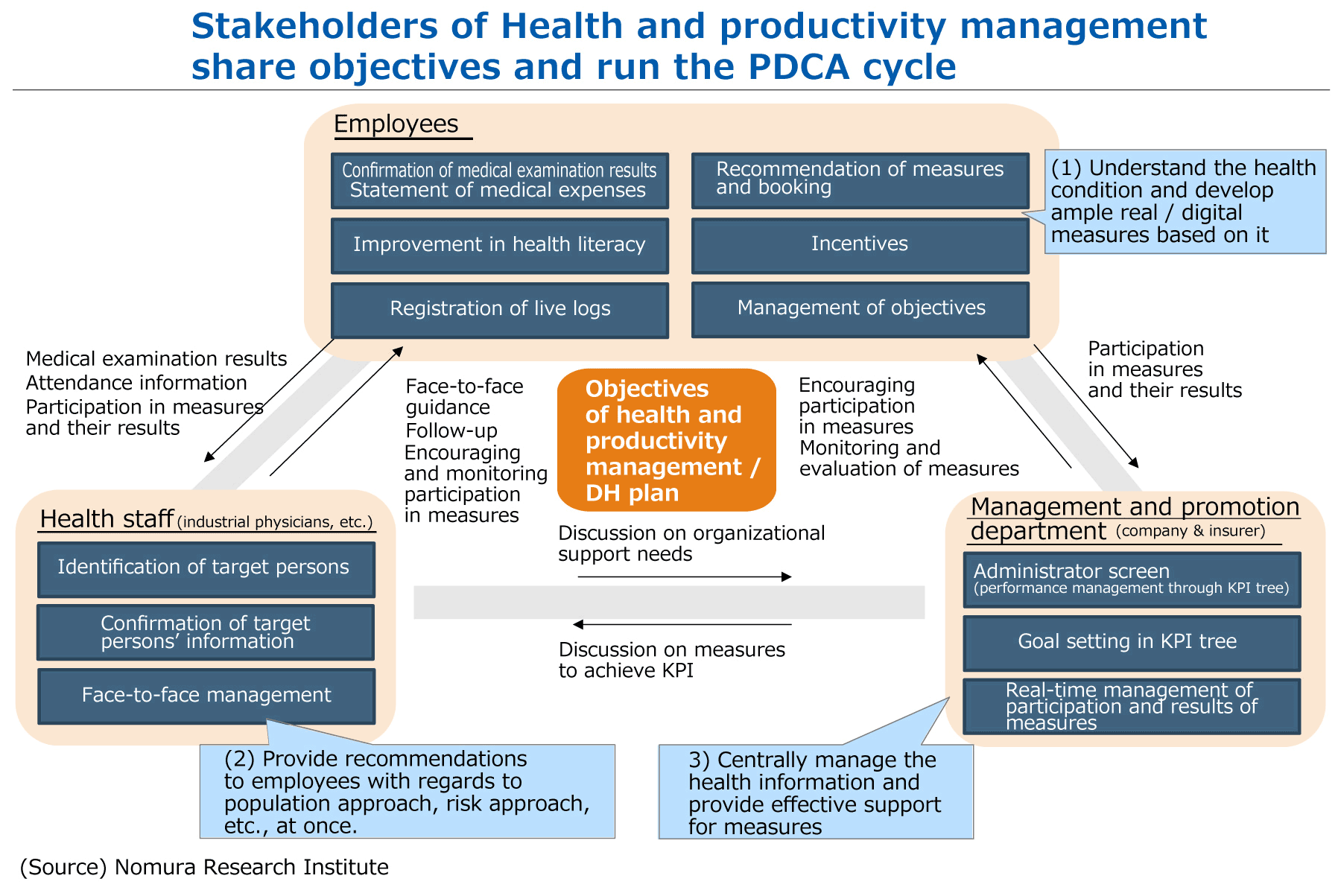
Strengthening “Health and productivity management” -- “Visualization” of effects through proper collaboration
“Health and productivity management” aims at increasing productivity, energizing the organization, and improving the performance, stock prices and image of the company by maintaining and managing the health of employees from business viewpoint. The selection of the health and productivity management brand and “Health and Productivity Management Organization (White 500)” certified companies are gradually becoming popular, and companies and groups working on health and productivity management are also increasing. We interviewed Mr. Kiichi Nishio (Nomura Research Institute), who has been involved in healthcare business for a long time, about the issues associated with health and productivity management and their countermeasures.
There is a growing interest in health and productivity management, isn’t it?
The number of applications (respondents in the Survey on Health and Productivity Management by METI) for White 500, which is certified by METI for companies working on health and productivity management, has increased steadily from 700 in FY 2017 to 1200 in FY 2018. In recent years, these companies have tended to face human resource shortages, and strongly intend to prevent employee turnover and secure talented resources. On the other hand, companies that have been working on it until now can also be seen to have stagnated. With no proper “visualization” of the merits of health and productivity management and the management risks, the companies have been struggling as they cannot show convincing results to the management, resulting in the subject not being prioritized as a management issue and ending up as a transient activity.
There are three main reasons for this. First, the expected results of health and productivity management, i.e., improvement in performance and reduction in employee turnover, should be evaluated from a mid-to-long term perspective as it does not deliver results in the short term. Second, the health-related data held by companies is limited and the medical information of each individual cannot be understood. Third, a wide range of healthcare data, such as medical fee, medical checkup, stress checkup and attendance records are not centrally managed, and hence, cannot be appropriately analyzed or utilized by linking with individuals and organizations.
A step forward with “Collaborative health” x “Healthtech”
One of the keys to break through this situation is “Collaborative health”. In this system, companies and insurers such as health insurance unions cooperate and collaborate to effectively implement measures for promoting employee health. The companies that do not have comprehensive data use the data possessed by the insurers to be able to implement more effective health measures. Until now, even if the insurers had wanted to encourage medical checkup for metabolic syndrome (a designated health checkup) to prevent lifestyle diseases, the only methods they had to do so were sending notifications and providing recommendations. However, it is expected that if companies actively promote this system among their employees, the consultation rate will improve. The Ministry of Health, Labor and Welfare has prepared a data health plan and requested the insurers to promote measures for six years and measure the results. This is also advantageous for collaborative health.
However, while companies are concerned about mental health in terms of “workplace safety” and “productivity improvement”, insurers tend to emphasize countermeasures for metabolic syndrome to prevent chronic diseases such as diabetes and renal failure for “optimization of medical expenses”. In order to overcome these gaps and collaborate, a platform must be created where they can continuously share information and examine issues, reconcile their objectives and vision and deepen their mutual understanding.
Secondly, digital technologies such as “Healthtech” should be effectively used. Although health management systems have been in use for a long time, many things such as data acquisition time, target persons, supervisor for data management, etc. were unorganized. If a wide variety of data can be centrally managed and properly linked using digital technologies, the issues will become clear. Further, effective measures can be taken and the PDCA cycle can be run to measure, evaluate, and improve the progress and results.
In order to assess the results, it is important to break down the mid-to-long term effects and incorporate the short-term metrics (step count, weight change, absence from work, etc.). By doing so, the progress status can be understood quickly and effectively, and the benefits that it offers to the management can also be presented.
In this way, for the first time, collaborative health and the services and infrastructure that support it can together enable continuous initiatives.

Support for health and productivity management through “WELLplus+” solution offered by NRI
The idea of “Collaborative health” x “Healthtech” can be incorporated in health and productivity management through the new service “WELLplus+”, for which NRI is carrying out development and demonstration. The relevant data is collected and centrally managed to enable stakeholders to share objectives and use information. For instance, an employee understands his health; therefore, if he has metabolic syndrome, he can get appropriate services such as recommendations of walking events. Companies can consider and implement effective health promotion measures by analyzing a wide variety of data. Industrial healthcare staff, such as industrial physicians, can also provide accurate advice and encouragement after a deep understanding of the patient based on a wide range of data. In this way, all the stakeholders of health and productivity management are benefited.
Japan is the world's fastest aging country. It is drawing the world’s attention in terms of the extent to which it is increasing the life expectancy and the number of people who can stay socially active for longer. We intend to provide services that can be utilized globally in the future by supporting health and productivity management in various ways, such as comprehensive analysis of health-related data, planning and promotion of health measures and PDCA management.
“WELL plus+” e-mail: health-tech-info@nri.co.jp
Profile
-
Kiichi Nishio
* Organization names and job titles may differ from the current version.